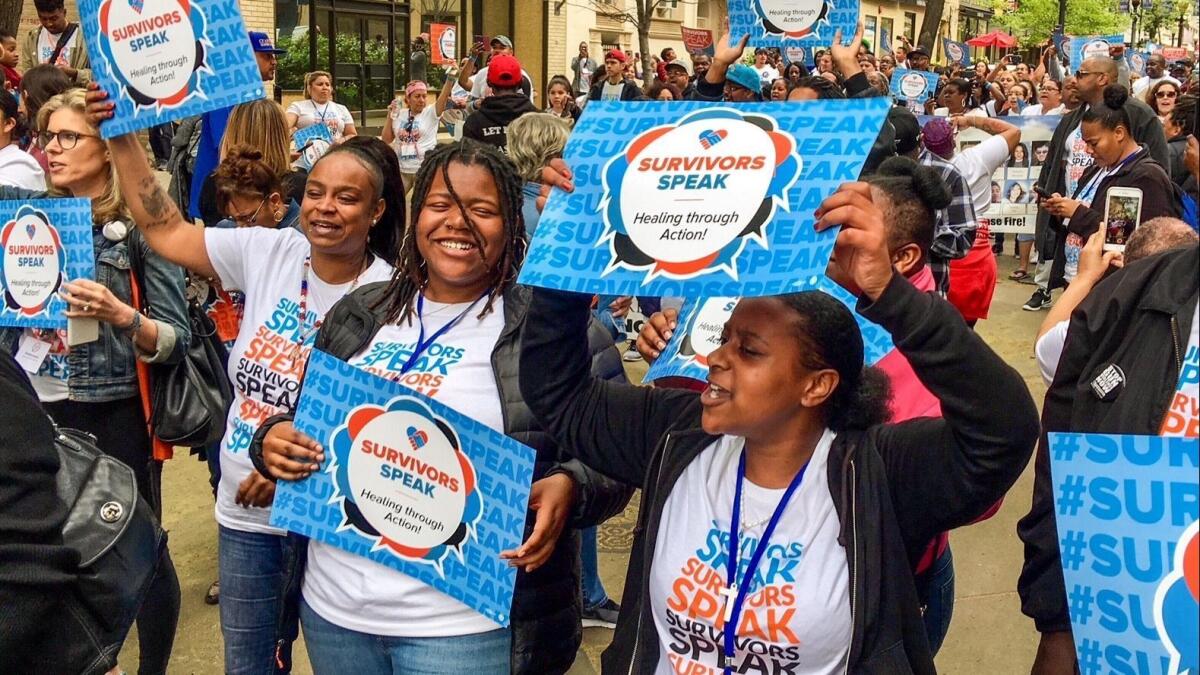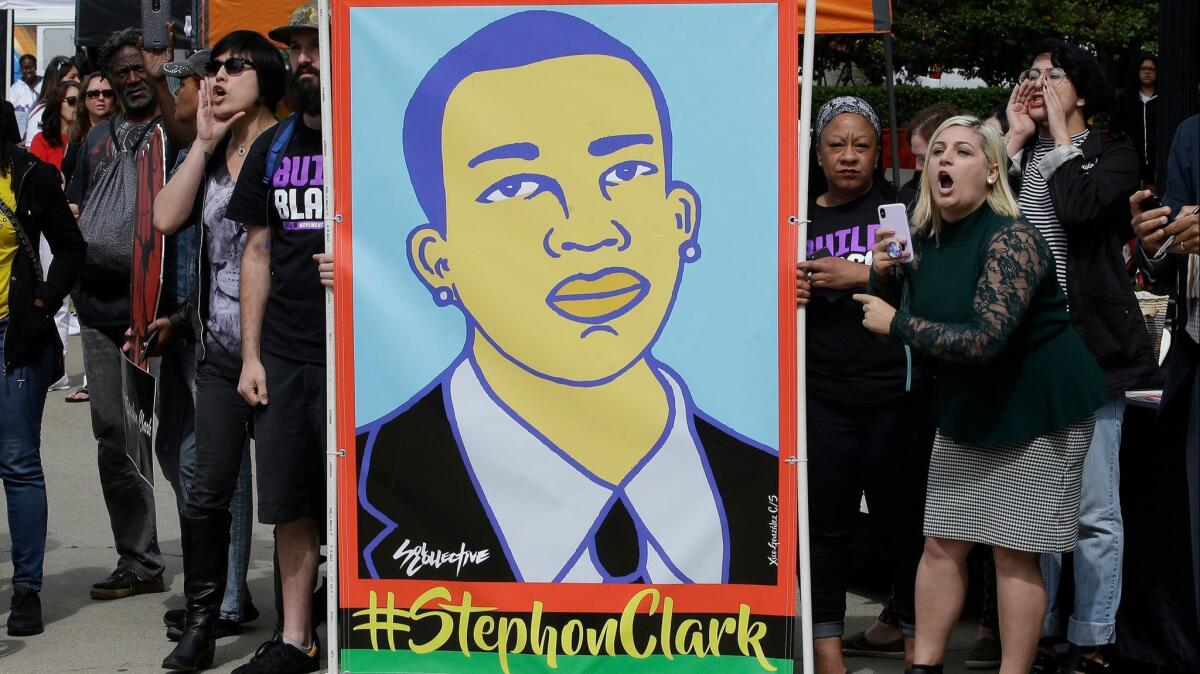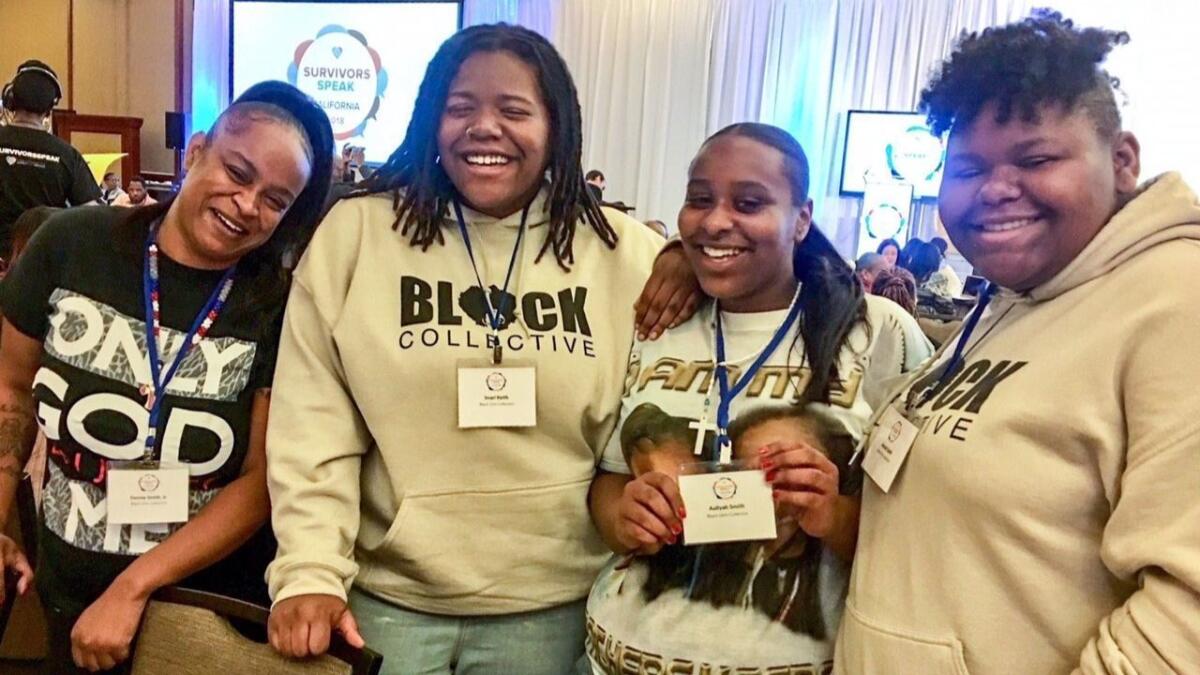Survivors of violent crime raise their voices in California to call for a new approach to criminal justice

Reporting from Sacramento — Her father, uncle, a cousin and two older brothers. Those are some of the family members 16-year-old Aaliyah Smith has lost to gun violence. Then there are her friends.
Jermaine Jackson Jr., 27, was shot and killed in 2016 while he painted over graffiti in San Francisco. Toriano “Tito” Adger, 18, was shot there a year later at a bus stop. He called Aaliyah, who was nearby, and warned her to run. She made it inside a library moments before the crack of gunfire.
Last week, Aaliyah was among hundreds who gathered in Sacramento for annual National Crime Victims’ Rights Week events, where calls were issued for a new approach to criminal justice and public safety in California, one that puts survivors at the center of policy. But a debate is brewing over what that entails.
As the state has rolled back sentencing laws through legislation and voter initiatives, a growing victims’ rights movement is pushing for alternatives to incarceration, with greater investment in rehabilitation services and a reevaluation of what it takes to make communities safe. On the other side, a smaller but visible coalition of crime survivors and law enforcement officials wants a return to tougher sentences and fewer people on parole.
The conversations are unfolding as a national spotlight is cast on victims pushing for change.
Young survivors of the February shooting at a Parkland, Fla., high school are seeking stricter gun laws. Victims of sexual assault have spurred efforts to overhaul a culture of sexual harassment and abuse in various fields and industries. And in Sacramento, where 22-year-old Stephon Clark was shot 20 times by police officers in his grandparents’ backyard last month, residents have flooded City Hall, blocked streets and access to Golden 1 Center to demand that those who killed him face justice.
Anna Cho Fenley, state director of the California-based Crime Survivors for Safety and Justice, describes it as an unprecedented time for survivors.
“We work to elevate the voices of those most harmed and least supported, young people, low-income communities, black and Latino communities,” she said. “But at the end of the day, it doesn’t matter what side of the aisle you sit on, the one thing we all can agree is we want healing and safety.”
In California, officials began to overhaul sentencing policies after federal judges imposed a new cap on the state’s prison population in 2011. A Los Angeles Times investigation found that the crowding crisis set the ground for a core group of five nonprofit foundations to lobby for a broader shift in criminal justice policy. They have helped fund a network of new community and victims’ rights groups to push for rehabilitation and youth programs.
One of those nonprofits is Californians for Safety and Justice. Robert Rooks, now its associate director, said the group first brought crime survivors and criminal justice experts together in late 2012.
At their first meeting, days after the mass shooting at Sandy Hook Elementary School, participants filled a wall with Post-Its noting problems with the criminal justice system in California, Rooks recalled.
Black and Latino youth disproportionately filling prisons. Few mental health programs in low-income and minority communities. Victim and burial services being denied to families, often based on ZIP Code.
“We realized that there was a missing voice in the policy-making discussion, and that missing voice was from those who experienced violence on a daily basis,” he said.
The group went on to form Crime Survivors for Safety and Justice in 2013. Founders say the organization has 6,000 members in California and about 10,000 nationwide. They have helped expand trauma recovery centers for people who have endured violence or loss, and they were a part of the coalition in support of Proposition 47, the 2014 ballot measure that downgraded six drug and theft crimes to misdemeanors and allowed some defendants to renegotiate their punishments.
After the ballot measure’s passage, members joined other advocacy organizations to steer the savings generated from incarcerating fewer people to community-based organizations for mental health, drug abuse and other social services. This year, many of those crime survivors are continuing the push for more state funding of rehabilitation and legislation to repeal other sentencing rules. Others have joined the push for a 2018 ballot measure to end life sentences for certain inmates convicted of all but the most violent crimes.
Almost 700 people from across the state met in Sacramento for the fifth annual march and rally at the state Capitol.
At a Monday panel, Parkland, Fla., shooting survivor Samantha Fuentes and #MeToo founder Tarana Burke took the stage. Calling on members to push for programs that help marginalized communities, Burke told the audience, “We know abuse is colorblind, but access to resources is not.”

California gubernatorial candidates call for a change in approach to public safety policies »
But not all survivors of violent crime agree with focusing on rehabilitation over punishment. Some victims are urging support of another proposed ballot initiative that would roll back previous voter measures, including Proposition 47, and expand the list of crimes classified as violent felonies used to determine which California prison inmates are eligible for early parole.
On the west steps of the state Capitol that day, where red roses lined hundreds of photos of crime victims, survivors and law enforcement officials struck a different tone, calling on lawmakers to put away violent criminals.
Nina Salarno Besselman, president of Crime Victims United of California, urged support for the group’s violent crime ballot initiative “to restore balance to our criminal justice system.”
“Legislators and this administration that has turned their back on us have not counted on you,” she said. “They have not counted on your strength and your resolve.”
Sacramento Dist. Atty. Anne Marie Schubert, one of three top prosecutors honored for their work in public safety, was met with a mix of boos, applause and chants of “Stephon Clark” when she stood at the lectern to address the crowd. Speaking over the protesters, she pledged to represent victims and help people get back on track, whether through school or youth intervention programs.
“I will always stand with victims,” she said as a handful of people held a banner with Clark’s photo, shouting, “Clark was a victim” and “Why are you protecting cops?”
Debbie Martin, who works with victims in Solano County, tried to speak to protesters and said she sees both sides. Her father was shot and killed when she was 9. She was in and out of the juvenile justice system until she was 18. One of the photos on display was of her nephew, Arturo Bravo.
“They are angry, and I understand that,” she said. “Everybody is angry here, but in a setting like this, you have to contain that anger and do something positive.”

Coverage of California politics »
Aaliyah and her cousins, Imari and Aniyah Keith, attended the Crime Survivors for Safety and Justice march last week as members of the Black Girls Collective, an organization they founded at school to talk about issues facing black women in America.
They didn’t always think of themselves as crime survivors, they said. Death has been a normal part of growing up.
The three helped pull each other through after their uncle, James Keith, was shot and killed in 2013, and again after Aaliyah’s father, Mitchell Smith, was shot and killed in a dispute over money last year. In many ways, Imari Keith said, they were the backbone of the family, always ready to dole out advice or lend friends a hand.
They have lost many of the men in their family.
“We are used to the funerals,” Imari Keith, 18, said. “At 13, I taught myself to be strong.”
Now the three want to push for programs that will bring other young survivors together and empower young black women like themselves.
Living in San Francisco, Aaliyah said, she has learned it is always best to tell people she loves them when saying goodbye.
“You never know if you’re going to see them again,” she said.
More to Read
Get the L.A. Times Politics newsletter
Deeply reported insights into legislation, politics and policy from Sacramento, Washington and beyond. In your inbox three times per week.
You may occasionally receive promotional content from the Los Angeles Times.











